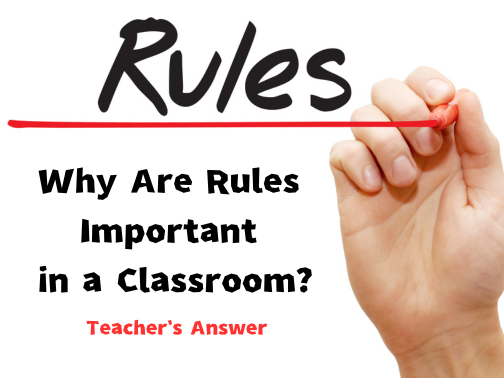Contents
Toggle
Meet David De’ Ath, co-founder, editor, and writer at Wonderful World English. With his extensive background as an English teacher, David provides valuable insights and practical tips on ESL for students and teachers alike.
Classroom rules are the cornerstone of an effective learning environment.
From young learners excitedly reciting their ABCs to older students grappling with complex topics, establishing clear rules and expectations is key to a smooth and enjoyable educational journey for both students and teachers.
These rules act as vital guidelines, fostering discipline, respect, and active engagement in the classroom.
More than just a learning space, the classroom is a community where students collaborate, interact, and grow together.
Without a well-defined set of rules, classrooms can quickly become chaotic and stressful, impacting everyone involved.
Classroom rules are vital for promoting discipline, responsibility, fairness, and safety in every classroom and fostering a positive learning environment. They help students develop key life skills and prepare them for the future, requiring consistent implementation by teachers for optimal educational benefits.
As an experienced educator who has guided thousands of students, I’ve witnessed the transformative impact of well-implemented classroom rules.
They are instrumental in shaping a positive and productive learning experience.
In this article, we’ll delve into the critical role of classroom rules and uncover why they’re indispensable in today’s educational landscape.
Ready to learn more?
Let’s dive in!

Why Rules are Important in a Classroom
Classroom rules are a crucial aspect for anyone involved in education.
Teachers universally recognize the need for firm classroom rules.
These guidelines are not just about maintaining order; they shape the entire learning experience.
When students know what is expected of them — to sit attentively, listen actively, respect others, and participate — it sets the stage for a successful learning journey.
Solid classroom foundations go beyond academic success.
They foster a social environment where students can grow, interact positively, and develop essential life skills.
The impact of these rules stretches far beyond the classroom walls, influencing students’ overall development.
But what makes these rules so vital?
There are numerous reasons, each playing a pivotal role in shaping a conducive learning environment.
Join me as we delve deeper into the significance of classroom rules and explore their multifaceted importance:

1. Provides a Structured Environment
The presence of a well-defined set of rules in a classroom brings a multitude of benefits, chief among them being the creation of a structured and orderly environment.
This structure is crucial for setting clear expectations and minimizing the likelihood of disruptive behaviors, which can be a significant challenge for any educator.
Establishing these expectations, particularly at the start of the school year, and reinforcing them consistently ensures that students understand and adhere to the required standards of behavior.
This approach builds a positive classroom culture conducive to effective learning and collaboration between students and teachers.
Such rules act as a guiding framework, helping students navigate various activities and tasks easily and confidently.
They are the bedrock upon which a positive, productive classroom culture is built, a culture that is integral to achieving success at all educational levels.
For insightful tips on fostering this kind of environment, be sure to check out the link below!
Related Article: How to Build a Positive Classroom Culture – Teacher’s Tips

2. Creates a Positive Learning Atmosphere
Establishing rules in a classroom is instrumental in creating a positive learning atmosphere, a key element for a successful educational experience.
These rules are more than mere guidelines; they are the foundation for fostering mutual respect between students and teachers, enhancing the overall atmosphere for everyone involved.
When students are clear about their boundaries, they are more likely to participate actively and communicate thoughtfully.
This respectful engagement cultivates a classroom environment where students feel a strong sense of belonging.
It encourages them to express their ideas freely, without fear of ridicule or judgment, thus enriching the learning experience for all.
A significant responsibility of a teacher is to keep students engaged and motivated, a task that varies in complexity from student to student.
Some learners may require more attention and creative approaches to maintain their interest and participation.
For effective strategies for engaging with and motivating challenging students, don’t miss the guide below.
It’s packed with valuable insights and practical tips to help you navigate these situations.
Related Article: How to Engage Difficult Students – Teacher’s Guide

3. Promotes Responsibility
Implementing rules in the classroom plays a pivotal role in teaching students about accountability and the responsibility that comes with their actions.
When students follow the rules set by their teachers, they gain a deeper understanding of how their behavior affects themselves and those around them.
This understanding fosters a sense of responsibility that extends beyond the classroom walls.
Such lessons in responsibility are invaluable.
They equip students with skills that are crucial for their future personal and professional development.
By adhering to classroom rules, students learn to develop self-discipline, better regulate their behavior, and make more responsible decisions.
This sense of responsibility and self-regulation is a key attribute that benefits individuals in all aspects of life.
The discipline and accountability learned in the classroom lay the groundwork for success in various future endeavors, shaping students into well-rounded, responsible individuals.

4. Ensures Fairness
Classroom rules play a critical role in ensuring fairness, an essential aspect of any educational setting.
They provide a framework that guarantees all students are treated equally, irrespective of their background, abilities, or personal characteristics.
This equal treatment under a consistent set of rules creates an atmosphere where every student has the same opportunity to learn and excel, fostering a sense of fairness and justice within the classroom.
Beyond ensuring equal treatment, rules also encourage respect for individual differences.
In any classroom, students come with diverse strengths, viewpoints, and areas for improvement.
By establishing rules that promote inclusivity, the classroom becomes a space where everyone’s unique qualities are recognized and appreciated.
Notably, guidelines that discourage discrimination are vital.
They encourage students to value and respect their peers, contributing to a classroom environment that is harmonious and accepting.
This inclusive atmosphere supports learning and prepares students for a diverse and interconnected world.

5. Creates a Safe and Inclusive Space
Establishing rules in a classroom is a fundamental step in preventing bullying and harassment.
Teachers play a crucial role in this process, not only by setting clear rules but also by modeling appropriate behavior themselves.
A firm stance with zero tolerance for any form of mistreatment or abuse is essential.
A classroom should be a sanctuary where students feel safe, supported, and free from fear of being targeted or harassed.
When students are aware of the consequences of bullying and harassing behaviors, they become more vigilant and proactive in reporting such incidents.
This awareness helps in maintaining a safe and respectful environment for everyone.
Additionally, rules in the classroom help cultivate respect and empathy among students.
They learn the importance of treating others with kindness, courtesy, and compassion.
This fosters an understanding and appreciation of the feelings and perspectives of their peers.
Such an environment nurtures a culture of empathy and compassion, where students support and uplift each other.
This positive atmosphere not only enhances the learning experience but also contributes to the overall well-being of every student.
Don’t miss the link below for those seeking inspiration on crafting effective classroom rules.
It offers valuable insights and free printable resources to help create a safe and inclusive space for learning.
Related Article: Classroom Rules Poster (Free Printables)

6. Enhances Learning and Productivity
One of the most significant benefits of establishing classroom rules is the reduction of distractions, thereby enhancing focus on learning activities.
Typical rules like prohibiting the use of electronic devices, talking, or being disruptive during lessons are essential in creating an environment that promotes concentration and attentiveness.
This focus is vital for the student’s academic progress and for maintaining a manageable and stress-free environment for teachers.
When distractions are kept to a minimum, students can engage more thoroughly with the material taught, improving grades and academic outcomes.
Well-implemented rules facilitate a more engaging learning experience.
They encourage active participation, collaboration, and respectful communication among students.
In such an environment, students are more likely to take an active role in their education and feel motivated to share ideas, ask questions, and seek clarification.
This results in a dynamic, interactive, and productive learning experience that benefits both students and teachers.
For those interested in exploring the importance of good classroom management further, the link below offers detailed insights and information.
Check it out to understand how effective management techniques can transform the educational experience.
Related Article: Why is Classroom Management Important? – Teacher’s Answer

7. Prepares students for the future
The importance of classroom rules extends far beyond the confines of school walls, preparing students for the multifaceted challenges of the future.
This preparation, rooted in the discipline and structure of the classroom, is a key aspect of education that should not be underestimated.
The behaviors and habits formed in the classroom often carry over into other areas of a student’s life.
Educators help students develop critical life skills by setting and enforcing solid rules.
Adherence to classroom rules teaches the importance of discipline, time management, and organization.
These skills are not just limited to the academic sphere; they are transferable to various aspects of life, including future professional environments and personal relationships.
This equips students with a robust foundation for success in their chosen path.
Moreover, classroom rules are crucial in instilling a sense of ethics and moral values.
Emphasizing honesty, integrity, and respect for others, these rules help shape students’ character.
As students grow and develop, the lessons learned about ethical conduct and respect for others guide their actions and choices, molding them into responsible and considerate adults.
In essence, classroom rules do more than just maintain order; they are a critical component in preparing young minds for the challenges and responsibilities of the future.
They lay the groundwork for developing well-rounded individuals who can contribute positively to society.
Check out the video below for some great insights into classroom management!
Conclusion
The significance of rules in any classroom setting is undeniable.
They are not just mere guidelines but the bedrock of a conducive and productive learning environment.
Rules foster discipline, instill a sense of responsibility, promote fairness, and create a safe and inclusive space for all students.
The role of rules extends beyond the immediate classroom setting.
They lay a crucial foundation for a positive learning atmosphere, one that prepares students not just for academic success but also for their future endeavors.
Through the application of these rules, students acquire valuable skills and develop attitudes that not only benefit their own personal growth but also positively impact their peers.
For teachers, the consistent implementation and reinforcement of these rules are essential.
Regular reminders and demonstrations of appropriate behavior are essential in ensuring that the learning environment is optimized for everyone’s benefit.
We hope this discussion has provided valuable insights into the importance of classroom rules and their far-reaching impact.
Wishing you a wonderful day filled with learning and growth!
Image Attribution: All images licensed via canva.com





